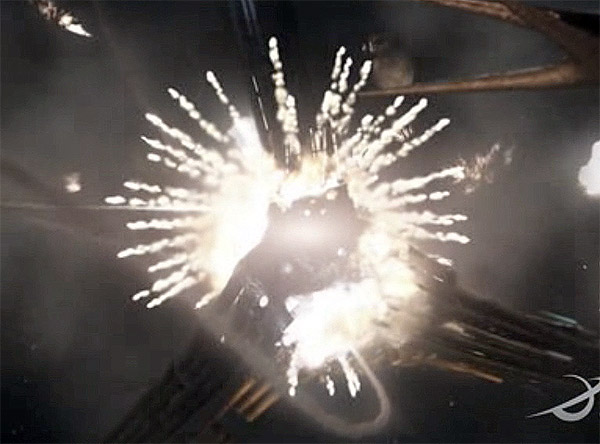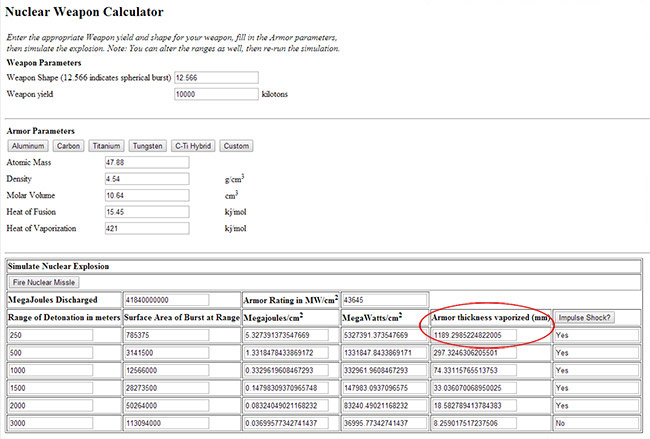We know. KitGuru should be 100% focused on delivering all the (tech) news and more in a hardcore, serious way. But, every now and then, we stumble across some information that's so intriguing that we feel the need to share. This is one of those times.
Anyone who's followed science fiction over the years will have seen space battles of epic proportions.
While phasers, pulse canons and hand blasters sound dandy and we're all quite sure what they do, we don't really have a frame of reference.
Not like a good old fashioned nuclear detonation. Now THAT's something we can visualise quite easily.
Clearly they are devastating, but how do space ships like the Battlestar Galactica take a nuclear licking and keep on ticking?
One of our readers had that question in mind while watching the re-runs on Sky 2. They researched and found a surprisingly useful web site that does the physics for you.
In space, there's no ‘blast‘ from the detonation, because there is no atmosphere to carry the pressure. So let's not worry about that.
Next we have serious radiation, but the ship in question is flying through all sorts of X-Rays, Gamma Rays and the like all the time, so we can assume it's heavily shielded.
Which leaves the pure heat itself – which will dissipate quickly in space, cos space is cold, right?

If anything, a space Nuke is at least pretty
The answer lies in a really cool page that has been created from the work of a Winchell Chung. You can find the baseline info here, but the cool stuff is on this neat page.
Assume a spherical bomb, you can leave the shape info untouched, while ramping the yield up to 10 megatons by adding 2 zeros.
Next, choose Titanium for the ship's armour and – finally – press the ‘Fire Nuclear Missile' button.
If the 10 megaton Cylon warhead detonates right up next to the Battlestar, then heat alone will melt away 1 metre of titanium armour.
Impressive, but no where near enough for those nasty Cylons to claim victory with their heat-based weapons.
KitGuru says: It seems strange to be talking about ‘Surviving a nuclear strike when you're standing less than 100m from the explosion, but for as long as man has been making weapons – other men have been creating defences. So, maybe, we will live in a time where war spills into space and a nuclear detonation is not fatal.
Fancy yourself as a star ship designer? If you have an opinion on how much armour is needed, then head over to Facebook and let us know.
 KitGuru KitGuru.net – Tech News | Hardware News | Hardware Reviews | IOS | Mobile | Gaming | Graphics Cards
KitGuru KitGuru.net – Tech News | Hardware News | Hardware Reviews | IOS | Mobile | Gaming | Graphics Cards




Uh that topless photo isn’t in the original website…
I wonder if there is anything like a nuclear shaped charge. Standard high explosives need to be in a shaped charge in order to penetrate current armor on tanks and APCs. I would imagine that if the energy generated with a nuclear detonation could be focused in a shaped charge, the metal used as the penetrator could blast through anything provided it didn’t vaporize from the heat.
Found the original image for those that came for that alone lol.
Sploins. 😀
Hint: It’s the Maxim Cylons Cover. 😀
“Which leaves the pure heat itself – which will dissipate quickly in space, cos space is cold, right?”
Temperature doesn’t correlate to conductivity, while it’s true that most areas of interstellar space are -270 celsius, the only way that heat can be removed is through is through radiating away, the heat will spread to the rest of the hull quickly.
Also that figure is based on a detonation 250m away, try 10m and you’ll find that 743 meters of armor will be burnt off. Then there’s the structural fatigue in the material due to rapid expansion and the spreading of the heat.